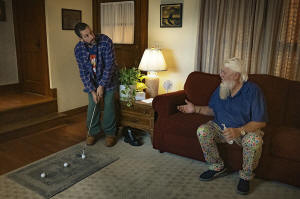‘Happy Gilmore’ became a cult comedy. 29 years later, Adam Sandler is
swinging again
[July 24, 2025]
By JAKE COYLE
NEW YORK (AP) — “Happy Gilmore” was born on the range.
When Adam Sandler was a kid growing up in New Hampshire, his father was
an avid golfer. He’d often take his son along to hit balls at the
driving range. But Sandler was uninterested in the sport, and usually
got antsy.
“Why don’t you bring a friend?” his dad told him. So Sandler took his
buddy, Kyle McDonough, a star hockey player who’d later turn
professional.
“He never played before but he was cracking the ball so far,” Sandler
recalls. “So when I started becoming a comedian and me and (Tim) Herlihy
were writing stuff and stand-up and talking about movies, I started
thinking about a guy who could hit it really big and had a hockey player
mentality.”
“Happy Gilmore,” released in 1996, was Sander and Herlihy’s second
movie, following “Billy Madison.” Sandler was just exiting “Saturday
Night Live.” Herlihy was Sandler’s roommate at New York University and
became a lawyer before Sandler got him to stick to writing comedy. (You
might remember the “Herlihy Boy” sketch.)
“We had just done our first movie, ‘Billy Madison,’ and we put every
idea we ever had for a movie in that movie,” says Herlihy. “So when they
said we could do another movie, it was like, ‘What are we going to do
this movie about?’”
“Happy Gilmore,” released in February 1996, became one of the most
beloved comedies of the ’90s and codified the hockey-style swing as a
mainstay on golf courses. “A hop, skip and a hit,” as Sandler says. The
movie also made comic heroes of Bob Barker, Christopher McDonald and
Carl Weathers, and made lines like “Are you too good for your home?”
plausible things to ask golf balls.

Like most cult comedies, “Happy Gilmore” didn’t start out an obvious
instant classic, though. “A one-joke ‘Caddyshack’ for the blitzed and
jaded,” wrote EW. “To describe Happy’s antics as boorish is putting it
mildly,” wrote The New York Times. “‘Happy Gilmore’ tells the story of a
violent sociopath,” wrote Roger Ebert. He called it “the latest in the
dumber and dumbest sweepstakes.”
“Happy Gilmore” was a box-office success, grossing $39 million in the
U.S. and Canada. And through worn-out DVDs and regular TV reruns, it
became a favorite to generations of golfers and a staple of goofy ’90s
comedy.
“I can’t even tell you how many times I’ve seen that movie,” says the
actor-filmmaker Benny Safdie, who co-directed Sandler in “Uncut Gems.”
“It was on an endless loop. I had the DVD and I just kept watching it. I
can close my eyes and see the movie end to end. It’s one of my favorite
movies.”
Now, nearly three decades later, and after years of batting away pleas
for a sequel, Sandler has finally put Happy’s Bruins jersey back on.
“Happy Gilmore 2,” which Netflix will debut Friday, is arguably the most
anticipated streaming release of the summer.
Avoiding a comedy sequel curse
Sandler was well aware of the checkered history of comedy sequels.
Movies like “Zoolander 2” and “Anchorman 2” have struggled to recapture
the freewheeling spirit of the originals. The movie Sandler counts as
his favorite, “Caddyshack” — so much so that he was initially hesitant
to make a golf comedy — spawned 1988's woebegone “Caddyshack II.”
“If someone brought it up to us, we were like, ‘Yeah, no, we’re not
going to do that,’” Sandler said in a recent interview alongside Herlihy.
“There was no moment we went ‘Aha.’ It just kind of happened. The last
couple years, we were talking about Happy and how it might be funny if
he was down and out.”
In “Happy Gilmore 2,” co-written by Sandler and Herlihy, Happy is a
decorated retired golfer with four sons and a daughter (played by
Sandler's daughter, Sunny Sandler). But after a tragic incident and
falling on hard times, he’s lured back into golf. This time, though,
Happy is an insider, motivated to protect the sport. Safdie co-stars as
the founder of Maxi Golf, a new circus-like tour with long hitters.
[to top of second column]
|

This image released by Netflix shows Adam Sandler, left, and John
Daly in a scene from "Happy Gilmore 2." (Scott Yamano/Netflix via
AP)
 “We thought it could be fun to write
something like that” says Sandler. “It kind of connected to our
lives and this age, and wanting to make a full-on comedy. There’s
nothing better than dropping a comedy and trying to make people
laugh, to us. It feels like why we originally got into this
business.”
Big, broad comedies have grown almost extinct in the decades since
“Happy Gilmore.” Returning to that style of comedy was, for Sandler
and Herlihy, the best reason to make the sequel. For the 58-year-old
friends and regular collaborators, it was a chance to riff like they
used to.
“We were outlining the story together and then we were like, ‘We
should watch the first one again, man,’” Sandler says. “We’re going
off of our memory of so many things, hanging out with Carl Weathers
and Bob Barker and all that stuff. Then we watched it and we were
like, ‘Oh, yeah.’ It was a tone.”
“It made a little more sense than ‘Billy Madison,’” says Herlihy,
“but we weren’t afraid to swing, swing, swing.”
A supporting cast of PGA winners
Cameos, of course, were a major part of “Happy Gilmore.” (The Bob
Barker scene was originally written for Ed McMahon.) In the years
since, many of the faces of the original have died, including
Barker, Weathers, Frances Bay, the hulking Richard Kiel and Joe
Flaherty, who played the heckler. Even the golf ball-stealing
alligator, Morris, has passed on. “Happy Gilmore 2,” unusually
elegiac for a proudly silly comedy, nods to all of them.
For the sequel, many others, like Travis Kelce, Bad Bunny and
Margaret Qualley, were lining up to be a part of it. So were pro
golfers. Just about all the big names in golf, including several
legends, appear. The day after winning Sunday’s British Open,
Scottie Scheffler flew to New York for the premiere.
Over the years, Herlihy and Sandler have seen a lot of them try “the
Happy Gilmore.”
“I feel like when these golfers try to do it, these pros, they’re 5%
thinking, ‘Maybe this will work,’” says Herlihy, laughing.

“I played with Bryson (DeChambeau) like a week ago and when he did
it, it was ridiculous,” adds Sandler. “He literally blasted it 360
and just kept walking. I was like, ‘Did he just smash the Happy
Gilmore and not even think about it?’”
It’s possible that “the Happy Gilmore” will even outlive the movies.
There's a good chance that, even as you read this, somewhere some
kid is trying it, hoping to get a laugh and maybe get it on the
fairway, too.
“When we were putting it together, I called my dad and asked him if
it was legal. He was like, ‘I don’t see why not,’” Sandler
remembers. “Then there are some people who look at it and go: ‘It
does help you swing hard. It gives you more momentum. You turn your
hips faster. Maybe it’s a good thing.’”
All contents © copyright 2025 Associated Press. All rights reserved |